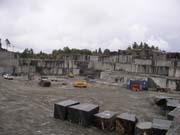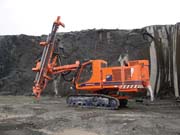
Although Lundhs Labrador and its merged companies have been in the quarrying business since the late 1800s, some of the most dramatic growth has occurred over the past decade. In 1996, the company merged with Fritzoe Blue Pearl AS, becoming Lundhs Labrador DA. Then, in 1999, Lundhs Labrador DA merged with Norsk Granitt AS and once again became Lundhs Labrador AS. And on the technology front, the firm has always been a believer in working with state-of-the-art quarrying equipment.
Lundhs Labrador AS is the sales company for four quarrying groups. This group of companies produces raw blocks of Labrador from 15 quarries in the Larvik area in Norway. Quarries in Larvik include sites for Blue Pearl, Emerald Pearl, Blue Pearl Fjord, Royal Blue TFV, Royal Blue TFM and Marina Blue Star. Additionally, in September 2000, the company took over a quarry in Northern Norway for Norwegian Rose marble.
Overall, the annual block production of Lundhs' quarries stands at over between 50,000 to 60,000 cubic meters. Products are delivered around the world, with Italy, Spain and the Far East as the company's main markets. Lundhs reports that worldwide demand for raw blocks is solid at the present time as well as in the future.
Over the years, traditional blasting methods have gradually been replaced by diamond wire sawing, and advances in drilling equipment have been a major factor in increasing production while also reducing the labor needed during stone extraction.

A new procedure for pilot holes
Over the past year, Lundhs Labrador has dramatically upgraded its procedures for creating the pilot holes, where the diamond wire is threaded. A recent upgrade was made in June of 2004 at the company's Emerald Pearl quarry in Klaastad, which has an annual production rate of 22,000 cubic meters per year and is the largest in all of Larvik. Working with Tamrock of Finland, the company invested in the Ranger 5002, a hydraulic, self-propelled, self-contained crawler-based surface drilling rig. The rig is equipped with the Ranger SW swinging mobile head.The holes that are created have a diameter of 2 to 3 1â„2 inches, utilizing extension rods measuring 1 1â„4, 1 1â„2 or 1 3â„4 inches. The holes are typically 21 to 23 meters in length, and are typically created in only 20 minutes, since the machine has a rate of 60 to 75 lineal feet per hour.
The latest advance to the unit is its hydraulic roll-over device, which makes it possible to accurately position the chain feed to the varied inclinations required for vertical and horizontal holes. The chain feed also includes two ground supports for added stability. The maneuverability of the unit helps a great deal in tight corners, and the design allows it to operate very close to the quarry floor, as holes can be created only 18 cm from the side surface.
Boom movements are handled by remote control, so the chain feed positioning can be accurately performed near the hole and without additional movement. Once positioning is set, the unit can be operated from the machine's heated cabin. After taking delivery of the machine, Lundhs' technicians learned how to use its controls in
only days.
Once the holes are made, the wire can be easily fed, and cutting is done with units from A. Benetti and Pellegrini of Italy.
A range of drilling equipment
The addition of the Ranger 5002 is the latest in a long line of Tamrock equipment in use at Lundhs Labrador. Other models supplied by Tamrock to Lundhs include the Maxiflexi, Miniflexi, Liner 100, Trimmer 200, Trimmer 200 pbv, Trimmer 240, Zoomrail, Commando 100, Commando 300, Track drills and DP 300.Many of these models could be found in action during Stone World's visit to Lundhs' quarry sites for Royal Blue granite. Lundhs reports that this variety differs from the classic Blue Pearl by having larger crystals and a bright light blue color. The TFV and TFM varieties, which are produced exclusively by Lundhs Labrador, are in demand worldwide because of their appearance and unique character. The company has a total of three quarries for Royal Blue that provide nearly identical qualities and color, and the overall capacity has been 8,000 cubic meters per year. There are 20 workers currently employed in these particular quarries, and the typical workday is from 7 a.m. to 4 p.m., 12 months per year.
A primary piece of equipment -- creating pilot holes and blast holes -- is the Tamrock Commando 300, which is a compact and maneuverable drilling rig with exceptional rough terrain capabilities. The machine has a hydraulic, self-propelled drilling unit on a four-wheel, oscillated drive carrier. It drills holes with a maximum recommended diameter of 2 1â„2 inches and a maximum practical length of 15 meters utilizing extension rods measuring 1, 1 1â„8 or 1 1â„4 inches.
The Commando 300 is equipped with the HL 300 hydraulic top hammer rock drill, which is mounted on an aluminum chain feed attached to an articulated boom, providing drilling coverage 10 square meters. The machine is operated by a simple, electronic remote control unit, and it is also equipped with a dust collection system, which gathers drilling dust from the hole into a plastic bag.
The Royal Blue quarries also utilize Tamrock's Miniflex with two drifters and its Maxiflex, which creates horizontal and vertical holes. The horizontal drilling creates lift holes where there is tension in the block.
Other Tamrock models in operation at Lundhs' site for Royal Blue Pearl include the Trimmer 200 PB, a drilling unit for secondary drilling and trimming the blocks. On this piece of equipment the Trimmer 200 frame is mounted with a paraboom unit on a four-wheel drive tractor. It drills vertically aligned holes with two HE 122 hydraulic top hammer rock drills. The rock drills are mounted on aluminum chain feeds attached to a frame, providing a 3.2-meter line drilling capacity. The frame can be rotated 85 degrees vertically and 30 degrees horizontally, and it can extend 200 mm from the ground pin without moving the boom. The frame is positioned with a 7.5-meter paraboom unit, which gives total drilling coverage of 80 square meters (860 square feet). With the paraboom unit, it is possible to square blocks that are up to 4.5 meters in height or that are positioned 2 meters lower than where the tractor is located.
Other equipment used during the extraction process are wheel loaders and Italian wire saws.
After blocks are taken from the quarry, they are trimmed with Tamrock Zoomrails, which are rail-mounted squaring units with three hydraulic drifters, three feeds and one telescopic boom.
Lundhs Labrador is working several different sites within the same quarry area, and the different sites are in various stages. At the time of Stone World's visit, one was working nine levels; another was working four levels; and yet another was working at eight levels.
Lundhs' current quarries have over 400 years of reserves, so it will be quarrying well into the future. And as technology increases, Lundhs is poised to continue its pattern of investment. Ultimately, the company may begin quarrying underground, if technology allows. “It could be 10 or 20 years, but we have to do it someday,†said Rolf Nilsen, quarry manager for Lundhs Labrador Royal Blue Quarries.